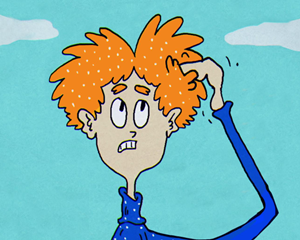Here in this abundant forest, Malassezia is equipped with everything it could ever need. Feasting constantly, it's in paradise. But wait -- what's this?
在这片茂密的丛林里,马拉色菌拥有绝佳生存条件,这里如天堂般供它欢宴作乐。但等等,这是什么?
In fact, Malassezia is a type of yeast that lives and dines on all of our scalps.
事实上,马拉色菌是一种酵母,它在我们所有的头皮上定居和进食。
And in about half of the human population, its activity causes dandruff.
它在近一半的人群中,导致了头皮屑的产生。
So, why do some people have more dandruff than others? And how can it be treated?
那么,为何有些人的头皮屑比较多?而我们又该怎么处理它呢?
We might consider ourselves individuals, but we're really colonies. Our skin hosts billions of microbes.
我们也许认为我们是独立个体,但我们其实是一个部落,我们皮肤表面定植着众多微生物。
Malassezia yeasts make themselves at home on our skin shortly after we're born.
马拉色菌自我们出生时便很快地在我们的皮肤上定居。
Follicles, the tiny cavities that grow hairs all over our body, make for especially popular living quarters.
毛囊,全身毛发从这些小凹陷中长出来,并打造出一个特别友好的生存空间。
Malassezia are fond of these hideouts because they contain glands that secrete an oil called sebum that's thought to lubricate and strengthen our hair.
马拉色菌特别喜欢这些藏身之处,因为这里包含了腺体,而这种腺体能分泌一种油脂,亦称皮脂,普遍认为,这能使我们的头发变得顺滑和强韧。
Malassezia evolved to consume our skin's proteins and oils.
马拉色菌进而以我们皮肤的蛋白质和油脂为食。
And because of its many sebum-secreting follicles, our scalp is one of the oiliest places on our body -- and consequently, one of the yeastiest.
因为头皮有许多分泌油脂的毛囊,所以它是我们全身最多油脂的地方之一,同时也是酵母最多的地方。
As these fungi feast on our scalp's oils, dandruff may form. This is because sebum is composed of both saturated and unsaturated fatty acids.
当这些酵母在头皮上大吃大喝时,头皮屑也随之产生。因为皮脂是由饱和脂肪酸和非饱和脂肪酸共同组成的。
Saturated fats neatly pack together. Unsaturated fats, on the other hand, contain double bonds that create an irregular kink in their structure.
饱和脂肪酸整齐地排列在一起。相反,非饱和以双键以双键不规则地连接在一起。
Malassezia eat sebum by secreting an enzyme that releases all of the oil's fatty acids.
马拉色菌分泌一种酶,分解皮脂中的所有脂肪酸。
But they only consume the saturated fats, leaving the unsaturated ones behind.
但他们只以饱和脂肪酸为食,剩下了非饱和脂肪酸。
These irregularly shaped leftovers soak into the skin and pry its barrier open, allowing water to escape.
而这些不规则非饱和脂肪酸渗入皮肤,破开了皮肤屏障,让水分外渗。
The body detects these breaches and responds defensively, causing the inflammation that gives dandruff it's itch.
身体检测到水分流失并做出防御性反应,发生炎症反应,产生令人发痒的头皮屑。
It also makes the skin cells proliferate to repair the damaged barrier.
它同时也使皮肤细胞增生,以修复损伤的屏障。

Usually, our skin's outer surface, or epidermis, completely renews itself every two to three weeks,
通常,我们皮肤的外表面或表皮,每两到三周就会完全更新一次。
Epidermal cells divide, move outwards, die, and form the skin's tough outer layer, which gradually sheds off in single cells far too small to see.
表皮细胞分裂、外移、凋亡,形成皮肤坚韧的屏障,并以肉眼无法看到的单细胞逐渐脱落。
But with dandruff, cells churn out quickly to correct the broken barrier, meaning they don't mature and differentiate properly.
但是对于头皮屑,细胞会迅速产生以修复破损的屏障,这就意味着它们不能正常成熟和分化。
Instead, they form large, greasy clumps around the hair follicle that are shed as visible flakes.
相反,它们会在毛囊周围形成又大又油的团块,并脱落成我们所看到的头皮屑。
This is how Malassezia's voracious appetite and our bodies reaction to its by-products lead to dandruff.
头皮屑正是由于马拉色菌嗜油脂以及我们对它副产品的反应而产生的。
Currently, the most effective way to get rid of dandruff is by using antifungals in things like shampoos, applied directly to the scalp, to kill Malassezia.
通常,摆脱头皮屑最有效的方法是用含抗真菌成分的洗发露直接抹在头皮上去杀死马拉色菌。
For those who experience dandruff, it usually comes and goes as sebum secretions vary throughout one's lifetime due to hormonal changes.
对于那些有头皮屑的人来说,皮脂分泌物通常随着人一生的激素水平的变化而变化。
But despite the fact that Malassezia colonize everyone to a similar extent, not everyone gets dandruff.
尽管马拉色菌在每个人身上的定植程度都差不多,但并不是每个人都有头皮屑。
Some people are more susceptible. Exactly why is unclear.
有些人会更加容易产生皮屑。而原因尚未明确。
Do people with dandruff have a certain genetic predisposition? Is their skin barrier more permeable?
有头皮屑的人有明确的遗传易感性吗?非饱和脂肪酸是否更容易渗入他们的皮肤?
Scientists are currently investigating if people with dandruff do, in fact, lose more water through their scalps,
目前,科学家正在研究有头皮屑的人群是否会因为头皮屑而丢失更多水分,
and whether this is what's leading their skin cells to proliferate.
或是否因此促进皮肤细胞的增殖。
Researchers are learning that Malassezia communicate with our immune system using small, oily molecules called oxylipins that regulate inflammation.
研究人员发现,马拉色菌通过一种名为氧化脂素的油性分子,与我们的免疫系统传递信息,从而调节炎症反应。
If they can find a way to inhibit inflammatory oxylipins and boost anti-inflammatory ones, they could develop new treatments.
如果他们能找到一种能阻断炎性氧化脂素产生的方法,或者能促进抗炎物质的生成,新的治疗方案就能研发出来了。
Scientists are also investigating if there's any benefit to our relationship with Malassezia.
科学家同时也在研究马拉色菌对于我们来说是不是也有好处。
They hypothesize that dandruff, which can be uncomfortable and embarrassing for us, creates a reliable, oily food source for the yeast.
他们猜测头皮屑在给我们带来不适与尴尬的同时,也为马拉色菌提供足够的油脂来源。
But dandruff isn't contagious or a great threat to our health.
但头皮屑不具有传染性,也没有对我们的健康造成很大威胁。
And Malassezia seem to excel at defending their territory, our skin, from other, more harmful microbes like Staphylococcus aureus.
而马拉色菌似乎很擅长保护自身领地,即我们的皮肤,不会受到如金黄色葡萄球菌这些有害微生物的伤害。
So, while scientists have gotten to the bottom of many mysteries surrounding this condition, it must be said: dandruff remains a head-scratcher.
因此,虽说围绕这些问题,科学家已经解开了谜底,但还是必须要说:头皮屑依旧让人挠头。













